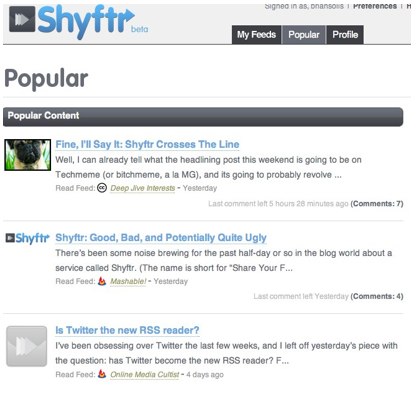
There’s an incredible discussion circling the blogosphere aka The 250 aka The Echo Chamber regarding distributed conversations and the potential loss of control of our content.
Normally I don’t let myself get caught up in every popular meme cycle, but this is a informative and important conversation and personally I think it’s worth your time. And, it just so happens to be a natural extension to my recent post, “Ladies and Gentlemen, The Conversation Has Left the Building,” which explores how conversations are slowly migrating away from blogs and moving to micro social networks such as Twitter, Pownce, Jaiku, FriendFeed, and now, Shyftr (more on Shyftr later).
Whether we’re ready or not, conversations are fragmenting and quickly and increasingly becoming difficult for the content source to 1) host conversations and 2) engage commenters and stay connected to the discussion across networks – especially if they don’t know where the conversations are taking place.
When I publish this post, I may or may not see comments here at PR 2.0. What is at the core of the confusion and discontent among many content producers, is that responses will take place wherever someone discovers or shares the content. And, most of the time, we’ll miss out on these distributed conversations, which in my opinion, are what truly power the progression of ideas and insight. Furthermore, new micro networks and content aggregators are allowing for comments directly in the aggregated flow or stream, which don’t make it back to the original post. And, that’s exactly where we need innovation. New tools and services that connect those comments back to the source will help create a manageable universe where people orbit the point of origin instead of creating a series of disparate galaxies of conversations around the same idea. But, I guess that’s the evolution that we need to acknowledge, the point of origin is relative to the reader and where they discover the content, not necessarily where we publish it.
For example, this post will by syndicated partially or in some cases completely, in FriendFeed, Jaiku, Tumblr, Twitter, Social Media Today, Marcom Professional, WebProNews , Gooruze, Pownce, and any other network where I have either manually or explicitly agreed to have content reappear. In each of those communities, readers have the ability to comment and in order for me to remain visible and also nurture relationships, I have to monitor everything individually. As good friend Stowe Boyd says, “just go with the flow.” Indeed he’s right. Our desire to stay connected will require a fragmented, proactive process of tracking down and responding to feedback.

But, now there’s a new twist in all of this, which was sparked by the release of Shyftr a new feedreader and social network mashup. In theory, it helps readers stay on top of their favorite feeds and also serves as a central place to discover new blogs and comment on compelling posts directly from within the network and also “friend” like-minded people. What’s at issue however, is that Shyftr and sites like it are flipping control away from publishers and in turn, becoming the hosts for our content – without necessarily giving credit or traffic back in return.
Just in case I lost you, Shyftr, which stands for Share Your Feeds Together, repurposes feeds and creates a social network around your favorites and the favorites of others. You can find feeds by searching key words in the Shyftr network, read your own feeds, as well as see the feeds that other users follow by viewing their list of favorites – they can view your list too. Popular stories are also promoted and showcased within the community, which introduces people to find new and interesting stories and bloggers.

It all sounds great, except that it serves posts in their entirety and lets readers comment at Shyftr without the author’s knowledge or triggering an alert to let them know that they have an opportunity to respond. To the untrained eye, readers who have stumbled across the content within the network, may never have the benefit of introduction back to the source. If you enjoy the writing, you can click “Shyft It” and have the feed instantly added to your list of favorites, without having to ever visit the blog. In order to find the point of origin, you have to click the headline twice – once in the summary to read the post and the second to get back to the feed. Some people call this scraping content and feel that it is a form of stealing intellectual property in order to monetize it.
Subscribe to my feed: Either way, Shyftr and the new breed of aggregated content apps and the social networks that connect people around them are actually good for us. As they evolve, our personal brands will extend into new communities where we may have never connected with new readers otherwise. We can’t fight it, we can only go where the conversations take us. Yes, it forces us outside of our comfort zone – hosting content and public reaction in one place. But, your level of participation after you publish, defines the relationships you create and cultivate in the Social w
eb. This is after all, Social Media ,and it’s powered by the democratization of conte
nt – even if it’s yours.
Make no mistake, the conversation has already left the building. The question is, are you ready to follow it?
Feedback and engagement, wherever it thrives, are the true sources of inspiration for anyone who produces content. Embrace that you have this opportunity to meet people in new places. Just focus your time on where those conversations produce the best return on your investment of time and expertise.
UPDATE: Shyftr changes its policy and will no longer repost content in its entirety, “Shyftr provides full attribution to publishers, links back to their sites, and we do not remove advertisements nor alter the content in any RSS feed. With that in mind, we have decided to revise the format around our discussions. We will only display the title, author, and date of an item where discussions occur outside of the reader. We deeply respect content publishers, and it is not our intention to cause unease.”
Personally, I think that the discussions surrounding Shyftr gave us a glimpse of the potential dark side of RSS. But at the end of the day, I still believe that even though it was fragmenting the conversation, it did so in a way that also exposed us (content producers) to new audiences.
Other articles worth your time:
Blog Comments Still Matter – Sarah Perez, RWW
Era of Blogger’s Control is Over – Robert Scoble
Fine, I’ll Say It: Shyftr Crosses the Line – Tony Hung
Should Fractured Feed Reader Comments Raise Blog Owners’ Ire? – Louis Gray
Should Comments be Portable – Valeria Maltoni
The Broken Conversation – Todd Defren
Other relevant stories on PR 2.0:
The Value of Online Conversations
The Art of Listening and Engagement
The Social Media Manifesto
Conversational Marketing
Will the Real Social Media Expert Please Stand Up
PR 2.0 = The Evolution of PR, Nothing Less, Nothing More
Connect with me on Twitter, Jaiku, LinkedIn, Pownce, Plaxo, FriendFeed, or Facebook.





just to add to the confusion, there’s also a similar conversation going on at profy.
i don’t see the reason for the big hullaballoo. maybe i’m myopic. but this whole scenario isn’t exactly new. how many conversations do you think are going on right now, as we speak, about, say, oprah winfrey’s telecourses? dozens if not hundreds. why would those conversations NOT happen at more than one location?
let’s face it, once we put something out on the net, we’ve lost control. if people like shyftr make money from our content, well, that’s a completely different story but that’s not what we’re talking about.
the bottom line: ideas and conversations cannot be controlled – neither by the “good” guys nor by the “bad” ones.
Brian,
Like I mentioned on my twitter, I find it interesting that there are two major conversations going on:
1. How conversations are fragmenting
2. How to track these fragmented conversations and if we should (Todd Defren).
I’ve written on the second point here:
Social Media Monitoring: Broken Conversations, Broken Tools
I’m curious what all the people writing about the fragmentation think about the social media monitoring aspect of it.
I agree with Isabella, this sort of thing has been happening since the Internet began.
When I started my archaeology discussion lists back in the mid-90’s, discussions often wandered from list to list and even into other forms of media.
The feeds that you mention here do not include discussion lists, nor older types of groups. There really isn’t one way of tracking discussions online (yet).
This is a great post. Could you please fix your blog template? The title of your post is missing in the page title.
I’ve seen this conversation go on in a million different places. As mentioned above, Todd Defren discusses it as does Daniel R. I commented on Todd’s blog along with several others, asking for someone to create an app that tracks it all. The need to track ideas and conversations is reflected in those old computer commercials where two people have the same idea in different buildings but no way to discover each other. Maybe, sadly, that’s just how it is. Until we reach a Star Trek type way of tracking information, we may need to accept that online conversations will mirror half of real life conversations. We’re all passing ships in the night that never crash into each other.
Thank you for this enlightening post on social media. We are broadening our understanding of it and we look forward to gaining some insight with the articles you provided. Thanks again!
Brian,
I fully agree with you…With developments such as these Services like SezWho that aggregate conversations (not content) are becoming more and more important.
-Jitendra
Illuminating post. While the actual impact of each new, more social than the last big step forward communication technology can be confusing, the underlying principle seems the same: conversations on the internet will change, evolve, and move beyond their creator’s original intention.
How do you maintain quality? That remains a mystery. At least to me.